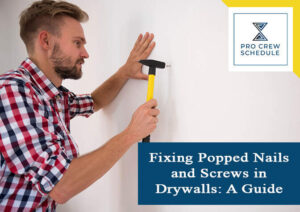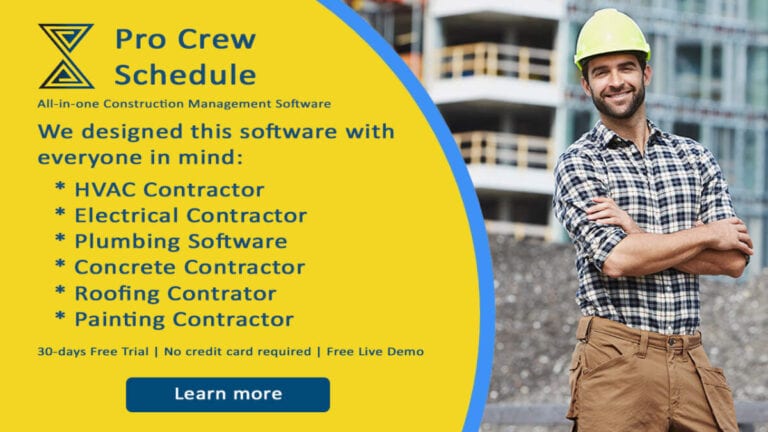Popped nails and even screws indicate a recurring problem behind the drywall, and this can be unavoidable because it appears anywhere on the surface. Reattaching the drywall directly to the frame will keep the issue from popping up all over again. To prevent popping nails from displaying and showing again, minor fixes can be applied to drywall quickly. The primary goal is to get rid of this problem forever.
Here in this blog, some of the most detailed procedures to fix this nail popping issue is outlined.
What are Nail Pops?
The small circles that often protrude from drywall both in ceilings and walls are identified as nail pops. Basically, the nail bulges and does not protrude further, yet they crack the paint surrounding them, running in horizontal and vertical lines. Nail pops are often described as cosmetic imperfections that show up in interior walls and drywall ceilings. Popping nails might not affect the wall structure, but in great numbers, the wall might lose drywall sections.
However, hammering back the nail pops frequently works, but it doesn’t fix the problem. When the drywall has been installed after two months, nail pops are slowly showing up again, one by one. There could be other reasons why nails are popping, and it serves as a sign. Potential signs can be identified like either the structure has different issues, or the building is perhaps settling. Using construction projects management, matters like this are easily identified and can be monitored.
Nail pops are often considered installation issues, yet several other factors beyond the craftsmanship and labor create this issue. Below are some of the common factors:
Poor framing work – nail pops are due to loose framing members. Wrapped lumber or twisted framing members fail to attach drywall to the studs and immediately often lead to nail pops.
· Shrinkage – framing lumber can be installed way in advance to the drywall. Environmental factors are proven to increase lumber moisture content. If the lumber starts shrinking and switching at different rates, the fastener is forced to pull through to the drywall. To prevent his issue from happening, ensure to store lumbers in a tightly covered dry storage.
· Drywall Installation – if the installation of drywall is done improperly, nail pops often showed. Other factors that affect the method are the wrong used of fastener length. That is why it is essential to account for the drywall thickness when selecting the right nail length.
Other reasons that nail popping occur can include:
· Poorly hung drywall – when drywall is hung improperly, the main reason for it is from overdriven drywall screws. However, loosely hung boards are sometimes the main reason why it results like that. It is imperative to use project management software to avoid improper implementation and incorrect installation of drywall.
· Incorrect nail and screw length – there is a standard measurement for the lengths of both screws and nails used for drywall. Drywall screws must never go more in-depth than 16mm or 5/8 inches. It must not also exceed to 22 mm or 7/8 inches into the studs.
· Excessive vibration – occupants have also contributed damaging effects on the drywalls. Pets and children were often running and jumping around while playing in the area. In time, it loosens things excessively, causing the nail and screws to pop.
How to Repair Popping Nails and Screws
The concept behind repairing bulging nails is to place the used drywall screws on both sides. By doing so, it effectively replaces the nails with screws without even messing out the nails. Drywall contractors have to know in advance that additional nail pops might form alongside the studs they are currently working on. Even repairing procedures often disturb the wallboards causing it to move. Nevertheless, it does help obtain stronger light sources that will help contractors quickly distinguish protrusions.
Before starting to fix these protruding items, it is best to wait patiently until the spring season. To manage a project is never an easy thing for contractors yet repairs are best to do during this period because humidity tends to increase. Let’s dive in now to the most detailed and intricate procedures in fixing this recurring issue. Read further below.
1. Hammer the Nail Back
Make sure to wear safety glasses and use a hammer to drive the bulging nail directly back into the wall. Be careful not to damage the drywall too much around it. Use also a smooth-headed hammer and never choose a grid head or waffle. As a result, round indentation is achieved for the walls alone. For the materials, drywall screws are used, including multi-purpose joint compounds.
Using construction scheduling software is worth-investing, especially for projects and repair services like this. The software application offers various cloud-based features purposely designed for more efficient project management. Besides, hammers and safety glasses are not the only tools/equipment to use because the following are also considered:
· Cordless drill
· 4-inch drywall taping knife
· Fine-grit sandpaper
· Nitrite or latex gloves
· Broad feathering knife (optional)
2. Secure the Nail
With two drywall screws, secure the drywall in the wooden studs, one on every nail side. Use a driver bit and the drill to drive a drywall screw into the wallboard, hitting the studs underneath. Do it continuously until the screw head folds the drywall paper. Next, place another drywalls crew on the opposite side of the popping nails. There must be about 1 to 2 inches distance between the screws and the nail.
3. Cover the Dimple
When applying a lighter layer of joint compound to the holes, use the taping knife used for drywall. Smoothen the excess with the knife to flush it directly to the walls. Never worry if the indentions are still present and visible because that is part of the process.
4. Dry, Sand, and Prime the Drywall
Joint compounds have to be allowed to dry for 2 to 4 hours. Next, apply a second coat of joint compound to ensure it will work out. If the patch will not blend well within the surrounding wall, using a broad feathering knife is a great solution to draw a wider and thin coat far from the walls. Make sure to inspect the surface area further. The joint compound shrinks when it dries, so it might be crucial to apply a third coat. Fine-grit sandpaper is used to sand the area top lightly.
5. Repairing the Wall
A quick drywall repair completes up the entire work in creating a smoother wall surface. If the fastener caused the drywall to crumble or break, make sure to remove the loose pieces. Next, fill in the hole with lighter spackling compounds for much faster drying time and better quality results. Apply the joint compounds using a drywall knife and draw it across the walls to level out the surface.
The filling process should also be repeated again to cover the new screws fully. Skim the immediate surface areas surrounding the screw heads. Lastly, allow the compounds to dry. If applicable, reapply 1 to 2 more additional layers to obtain full coverage of the screws.
6. Patching the Drywall
To finish the drywall once again, particularly in the affected areas, mixing joint compounds is the next thing to do and re-patching the area will come after. Remove the joint compound and the loose paint in the area. Now is the right time to utilize the setting-type of a joint drywall compound. It is a compound proven to produce optimum results as it fewer shrinks than the pre-mixed joint.
When mixing the joint compounds it will require additional efforts the mixing process. A collaborative effort between project managers and the team tends to increase with the use of technologies and advanced software applications. Hence, it is worth investing in.
Next, apply the second coat while feathering the edges past the double layers. By doing so, blending the patch into the walls is easier. In some cases, a few areas require a third coat of joint compounds. All of the coats should be applied with the use of a putty knife. One important thing to remember is that the mud has to be spread evenly across the surface area. Let it all set once again.
Below are other detailed and practical instructions to be followed to fix bulging nails and screws:
· Drywall screws must be utilized instead of nails. Screws often offer a much better installation process and it also reduces the drywall movement.
· If the framing is already installed way before the drywall, it is essential to protect it from moisture. Using kiln-dried lumber, particularly for framing, is also a good option.
· Avoid fasteners within 15 inches of any wall to stop nails from showing.
· Install new screws, paint and patch prime. Ensure that you are using the proper screw length.
· Glue and screw the drywall is suggested. The Gypsum Association usually extends the screw spacing for walls, mostly when panels are glued and screwed.
Key Takeaways
Fixing popped nails and screws isn’t tough as what others assumed. However, it requires more than just driving the fasteners back to the walls. Professional results are best obtained using the right tools and equipment. With the implementation of practical solutions and following basic to intricate procedures, popping nails and screws will be prevented. Hence, any of your clients will be satisfied with your drywall repair services.







